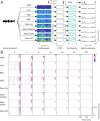Simple transformations capture auditory input to cortex
- PMID: 33097665
- PMCID: PMC7668077
- DOI: 10.1073/pnas.1922033117
Simple transformations capture auditory input to cortex
Abstract
Sounds are processed by the ear and central auditory pathway. These processing steps are biologically complex, and many aspects of the transformation from sound waveforms to cortical response remain unclear. To understand this transformation, we combined models of the auditory periphery with various encoding models to predict auditory cortical responses to natural sounds. The cochlear models ranged from detailed biophysical simulations of the cochlea and auditory nerve to simple spectrogram-like approximations of the information processing in these structures. For three different stimulus sets, we tested the capacity of these models to predict the time course of single-unit neural responses recorded in ferret primary auditory cortex. We found that simple models based on a log-spaced spectrogram with approximately logarithmic compression perform similarly to the best-performing biophysically detailed models of the auditory periphery, and more consistently well over diverse natural and synthetic sounds. Furthermore, we demonstrated that including approximations of the three categories of auditory nerve fiber in these simple models can substantially improve prediction, particularly when combined with a network encoding model. Our findings imply that the properties of the auditory periphery and central pathway may together result in a simpler than expected functional transformation from ear to cortex. Thus, much of the detailed biological complexity seen in the auditory periphery does not appear to be important for understanding the cortical representation of sound.
Keywords: Marr’s levels of analysis; auditory cortex; encoding models of neural responses; models of the auditory periphery; predicting responses to natural sounds.
Copyright © 2020 the Author(s). Published by PNAS.
Conflict of interest statement
The authors declare no competing interest.
Figures





References
-
- Marr D., Poggio T., “From understanding computation to understanding neural circuitry” (Tech. Rep. AIM-357, Artificial Intelligence Laboratory, Massachusetts Institute of Technology, 1976).
-
- Lyon R. F., “A computational model of filtering, detection, and compression in the cochlea in ICASSP ’82” in IEEE International Conference on Acoustics, Speech, and Signal Processing, (Institute of Electrical and Electronics Engineers, 1982), pp. 1282–1285.
-
- Wang K., Shamma S., Self-normalization and noise-robustness in early auditory representations. IEEE Trans. Speech Audio Process. 2, 421–435 (1994).
-
- Wang K., Shamma S. A., Auditory analysis of spectro-temporal information in acoustic signals. IEEE Eng. Med. Biol. Mag. 14, 186–194 (1995).
-
- Chi T., Ru P., Shamma S. A., Multiresolution spectrotemporal analysis of complex sounds. J. Acoust. Soc. Am. 118, 887–906 (2005). - PubMed
Publication types
MeSH terms
Grants and funding
LinkOut - more resources
Full Text Sources

